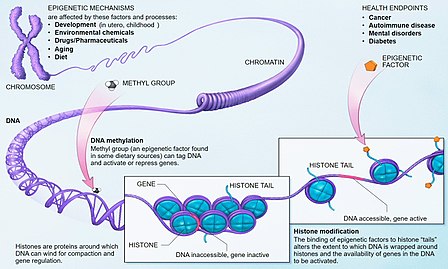|

CLICK ON weeks 0 - 40 and follow along every 2 weeks of fetal development
|
||||||||||||||||||||||||||||
|
Developmental biology - Gene Methylation Gene Regulation, Digital and Random? Using this high-resolution approach, Milosavljevic and colleagues discovered that the SD-ASM mediated gene works like a house thermostat. A house thermostat has a preset temp at which the air conditioning (AC) will turn on when the house air is above that temp. The process is digitally regulated, the AC machine is either on to cool the interior temp, or off. There is no intermediate level. "We also discovered the process of gene regulation is stochastic [random]," said Milosavljevic, also a member of Baylor College of Medicine, at the Dan L Duncan Comprehensive Cancer Center. "Returning to the thermostat analogy, the probability of the AC turning on when the temperature reaches a preset value of 74 degrees is 100 percent. In a stochastic thermostat, the probability of the AC machine turning on increases as the temperature reaches 74 degrees, but it is not 100 percent 'determined to occur' when that temperature is reached. There is still a chance that the AC will not turn on at 74 degrees, but the probability of the AC turning on is higher as the temperature rises." In the case of the gene regulation mechanism, specific genetic variants that control the paternal and maternal genes may represent different 'preset temperature values' in the thermostat analogy, causing differences in the degree to which maternal or paternal genes are expressed in each human cell. "For example, for a particular gene in a neuron, the maternal genetic 'thermostat' may be set to 'turn on the gene at 73 degrees', and the paternal gene at 74 degrees. That means that the paternal and maternal genes are turned on differently which creates an imbalance between the two copies of that gene," according to Milosavljevic. "We found that between 5 and 8 percent of the epigenome shows this type of imbalance." Implications of this finding extends to a number of biomedical fields. "For instance, our findings may add another layer of complexity - so far not taken into account in certain intricate human diseases. If we add this layer of complexity, we might be able to better understand how dosage-sensitive genes may contribute to human diseases that have so far been hard to tackle, such as neuropsychiatric disorders,"according to Milosavljevic. "This work is meant to provide important insight into a new layer of biological complexity, hopefully creating the basis for subsequent research in specific diseases." Abstract To assess the impact of genetic variation in regulatory loci on human health, we construct a high-resolution map of allelic imbalances in DNA methylation, histone marks, and gene transcription in 71 epigenomes from 36 distinct cell and tissue types from 13 donors. Deep whole-genome bisulfite sequencing of 49 methylomes reveals sequence-dependent CpG methylation imbalances at thousands of heterozygous regulatory loci. Such loci are enriched for stochastic switching, defined as random transitions between fully methylated and unmethylated states of DNA. The methylation imbalances at thousands of loci are explainable by different relative frequencies of the methylated and unmethylated states for the two alleles. Further analyses provide a unifying model that links sequence-dependent allelic imbalances of the epigenome, stochastic switching at gene regulatory loci, and disease-associated genetic variation. Authors: Vitor Onuchic, Eugene Lurie, Ivenise Carrero, Piotr Pawliczek, Ronak Y. Patel1, Joel Rozowsky, Timur Galeev5, Zhuoyi Huang1, Robert C. Altshuler, Zhizhuo Zhang, R. Alan Harris, Cristian Coarfa, Lillian Ashmore, Jessica W. Bertol, Walid D. Fakhouri, Fuli Yu, Manolis Kellis, Mark Gerstein, Aleksandar Milosavljevic. The authors declare no competing financial interests. Return to top of page | Aug 27, 2018 Fetal Timeline Maternal Timeline News News Archive  This diagram represents how DNA is compressed by wrapping around histone methylation molecules to fit compactly within a cell nucleus. Epigenetics most often denotes changes from this compression that affect gene function. When DNA is loosely wrapped around histone it functions or is "expressed". Repressor proteins can also attach to silence regions of the DNA strand.
|
||||||||||||||||||||||||||||


%20SCIENCE%205066.png)